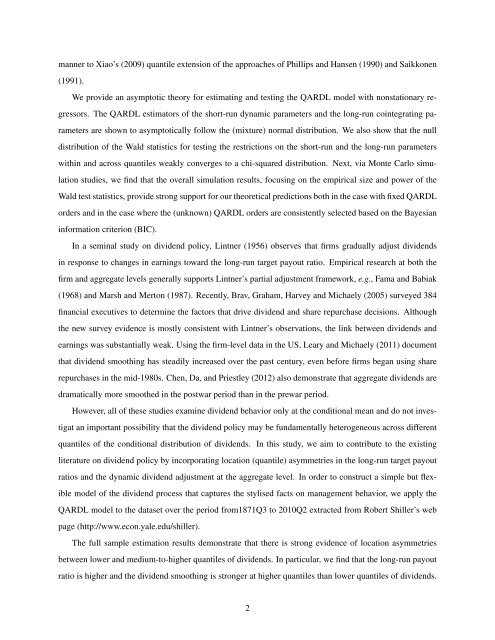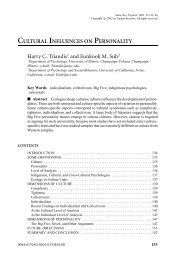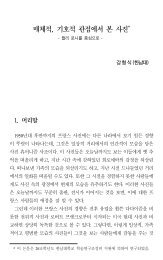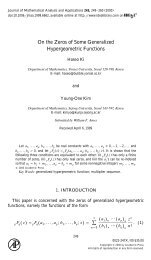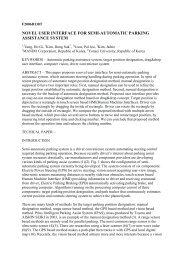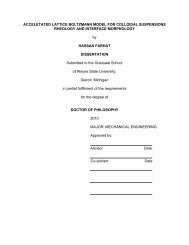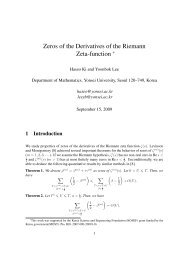Quantile Cointegration in the Autoregressive Distributed-Lag ...
Quantile Cointegration in the Autoregressive Distributed-Lag ...
Quantile Cointegration in the Autoregressive Distributed-Lag ...
Create successful ePaper yourself
Turn your PDF publications into a flip-book with our unique Google optimized e-Paper software.
manner to Xiao’s (2009) quantile extension of <strong>the</strong> approaches of Phillips and Hansen (1990) and Saikkonen<br />
(1991).<br />
We provide an asymptotic <strong>the</strong>ory for estimat<strong>in</strong>g and test<strong>in</strong>g <strong>the</strong> QARDL model with nonstationary regressors.<br />
The QARDL estimators of <strong>the</strong> short-run dynamic parameters and <strong>the</strong> long-run co<strong>in</strong>tegrat<strong>in</strong>g parameters<br />
are shown to asymptotically follow <strong>the</strong> (mixture) normal distribution. We also show that <strong>the</strong> null<br />
distribution of <strong>the</strong> Wald statistics for test<strong>in</strong>g <strong>the</strong> restrictions on <strong>the</strong> short-run and <strong>the</strong> long-run parameters<br />
with<strong>in</strong> and across quantiles weakly converges to a chi-squared distribution. Next, via Monte Carlo simulation<br />
studies, we f<strong>in</strong>d that <strong>the</strong> overall simulation results, focus<strong>in</strong>g on <strong>the</strong> empirical size and power of <strong>the</strong><br />
Wald test statistics, provide strong support for our <strong>the</strong>oretical predictions both <strong>in</strong> <strong>the</strong> case with fixed QARDL<br />
orders and <strong>in</strong> <strong>the</strong> case where <strong>the</strong> (unknown) QARDL orders are consistently selected based on <strong>the</strong> Bayesian<br />
<strong>in</strong>formation criterion (BIC).<br />
In a sem<strong>in</strong>al study on dividend policy, L<strong>in</strong>tner (1956) observes that firms gradually adjust dividends<br />
<strong>in</strong> response to changes <strong>in</strong> earn<strong>in</strong>gs toward <strong>the</strong> long-run target payout ratio. Empirical research at both <strong>the</strong><br />
firm and aggregate levels generally supports L<strong>in</strong>tner’s partial adjustment framework, e.g., Fama and Babiak<br />
(1968) and Marsh and Merton (1987). Recently, Brav, Graham, Harvey and Michaely (2005) surveyed 384<br />
f<strong>in</strong>ancial executives to determ<strong>in</strong>e <strong>the</strong> factors that drive dividend and share repurchase decisions. Although<br />
<strong>the</strong> new survey evidence is mostly consistent with L<strong>in</strong>tner’s observations, <strong>the</strong> l<strong>in</strong>k between dividends and<br />
earn<strong>in</strong>gs was substantially weak. Us<strong>in</strong>g <strong>the</strong> firm-level data <strong>in</strong> <strong>the</strong> US, Leary and Michaely (2011) document<br />
that dividend smooth<strong>in</strong>g has steadily <strong>in</strong>creased over <strong>the</strong> past century, even before firms began us<strong>in</strong>g share<br />
repurchases <strong>in</strong> <strong>the</strong> mid-1980s. Chen, Da, and Priestley (2012) also demonstrate that aggregate dividends are<br />
dramatically more smoo<strong>the</strong>d <strong>in</strong> <strong>the</strong> postwar period than <strong>in</strong> <strong>the</strong> prewar period.<br />
However, all of <strong>the</strong>se studies exam<strong>in</strong>e dividend behavior only at <strong>the</strong> conditional mean and do not <strong>in</strong>vestigat<br />
an important possibility that <strong>the</strong> dividend policy may be fundamentally heterogeneous across different<br />
quantiles of <strong>the</strong> conditional distribution of dividends. In this study, we aim to contribute to <strong>the</strong> exist<strong>in</strong>g<br />
literature on dividend policy by <strong>in</strong>corporat<strong>in</strong>g location (quantile) asymmetries <strong>in</strong> <strong>the</strong> long-run target payout<br />
ratios and <strong>the</strong> dynamic dividend adjustment at <strong>the</strong> aggregate level. In order to construct a simple but flexible<br />
model of <strong>the</strong> dividend process that captures <strong>the</strong> stylised facts on management behavior, we apply <strong>the</strong><br />
QARDL model to <strong>the</strong> dataset over <strong>the</strong> period from1871Q3 to 2010Q2 extracted from Robert Shiller’s web<br />
page (http://www.econ.yale.edu/shiller).<br />
The full sample estimation results demonstrate that <strong>the</strong>re is strong evidence of location asymmetries<br />
between lower and medium-to-higher quantiles of dividends. In particular, we f<strong>in</strong>d that <strong>the</strong> long-run payout<br />
ratio is higher and <strong>the</strong> dividend smooth<strong>in</strong>g is stronger at higher quantiles than lower quantiles of dividends.<br />
2


